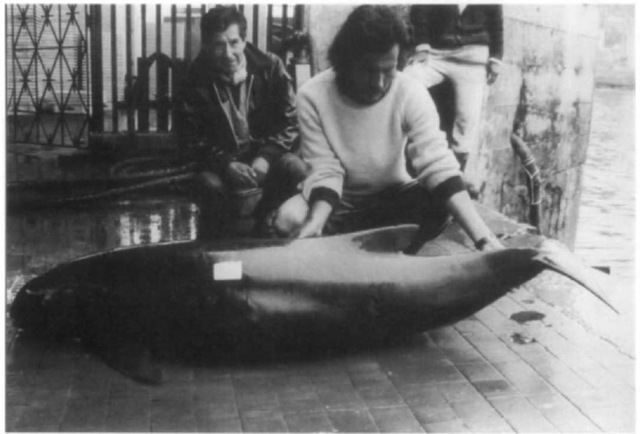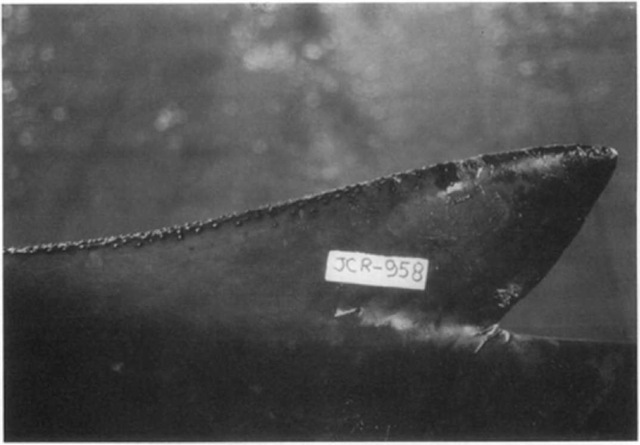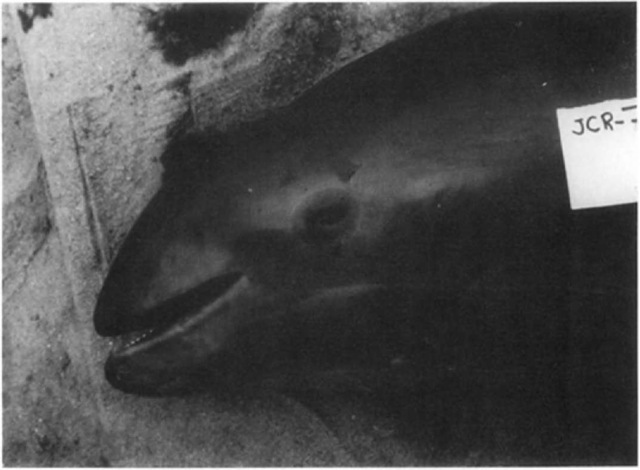Described by Hermann Burmeister in 1865. this is one * of the five species of the family Phocoenidae, a group r of cetaceans whose members share the presence of small, spade-shaped teeth. The Spanish name for this porpoise, “marsopa espinosa” or “spiny porpoise,” refers to the series of tubercles present in the dorsal fin. It was long considered a rare species, but research in the last decade has shed light on the natural history and conservation problems of this cetacean.
I. Distribution
Burmeister’s porpoise is restricted to South American waters. from Santa Catarina. in southern Brazil, around the Cape Horn north to Bahia de Paita, in northern Peru. As more studies focus on this species, its range appears to be continuous. The existence of Pacific and Atlantic stocks has been proposed, but no studies have yet addressed this matter.
II. External Form
In the Atlantic part of its range, Burmeister’s porpoises may grow up to 200 cm: off the Pacific coast, the maximum size recorded corresponds to a female 183 cm long from Peruvian waters. The males, however, are significantly larger than females. The body is robust, with a small, blunt head, and proportionately large flippers (Fig. 1). A conspicuous feature of the species is the dorsal fin, which is triangular in shape and canted backward in an unusual fashion for a cetacean. Moreover, the leading edge of the dorsal fin has a series of small tubercles that become sharper as the animal grows (Fig. 2).
Coloration varies from dark gray to brownish gray on the back and sides, and a light gray ventral region. Surrounding the eye, a dark patch can often be noted. A dark gray stripe runs from the chin to the base of the flipper. This “flipper stripe” is asymmetrical, being markedly wider on the left side (Fig. 3). A pair of stripes is also present on the abdominal region. The pattern of these ventral stripes is sexually dimorphic.
Figure 1 Side view of a Burmeister’s porpoise caught in Peruvian waters.
Figure 2 The dorsal fin of a Burmeister’s porpoise.
Figure 3 Close-up of a Burmeister’s porpoise head, showing the eye patch and flipper stripe.
III. Habitat and Ecology
Although it is considered a coastal, inshore species, Burmeister’s porpoise has been observed up to 50 km from shore, at a depth of 60 m. These movements to offshore waters appear to respond to migration of the prey species. Some animals have been recorded upstream in the Valdivia River, in southern Chile.
Burmeister’s porpoise feeds on a variety of both pelagic and demersal fish, including anchovies, hake, jack mackerel, sardine, drums, and, less frequently, squids and shrimps.
At sea this porpoise is difficult to observe. It swims with a gentle roll on the surface, with little of its body exposed. This behavior may change to very fast swimming when approached by a boat, although not porpoising or performing bow riding. The group size usually ranges from 2 to 8 animals, but aggregations of 22 and up to 70 porpoises have been reported.
IV. Reproduction
Females reach sexual maturity when they are 154.8 cm long, shorter than the length of attainment of sexual maturity for males, estimated to be 159.9 cm. There does not appear to be seasonality in the reproductive cycle of the male. Pregnancy may last 11-12 months, and the length at birth is approximately 86 cm. Some pregnant females may be simultaneously lactat-ing, indicating that annual reproduction may occur. Based on the counting of dentine layers in the teeth, one poipoise 174 cm long was estimated to be 8 years old.
V. Interaction with Fisheries
The coastal habitat of Burmeister’s porpoise makes it vulnerable to fishing activity. Through its range, the species be come incidentally entangled in fishing nets. In Uruguay, several porpoises became entangled in shark nets. In the southern part of Argentina, several fisheries account for the capture of a small number of porpoises. In southern Chile, entanglements and possible harpooning of animals have been reported. From central Chile to northern Peru the species becomes incidentally entangled in nets set for a variety of small pelagic and demersal fishes, sharks, and rays. Only in Peru do captures of Burmeister’s porpoises reach an annual figure of 2000 animals.



